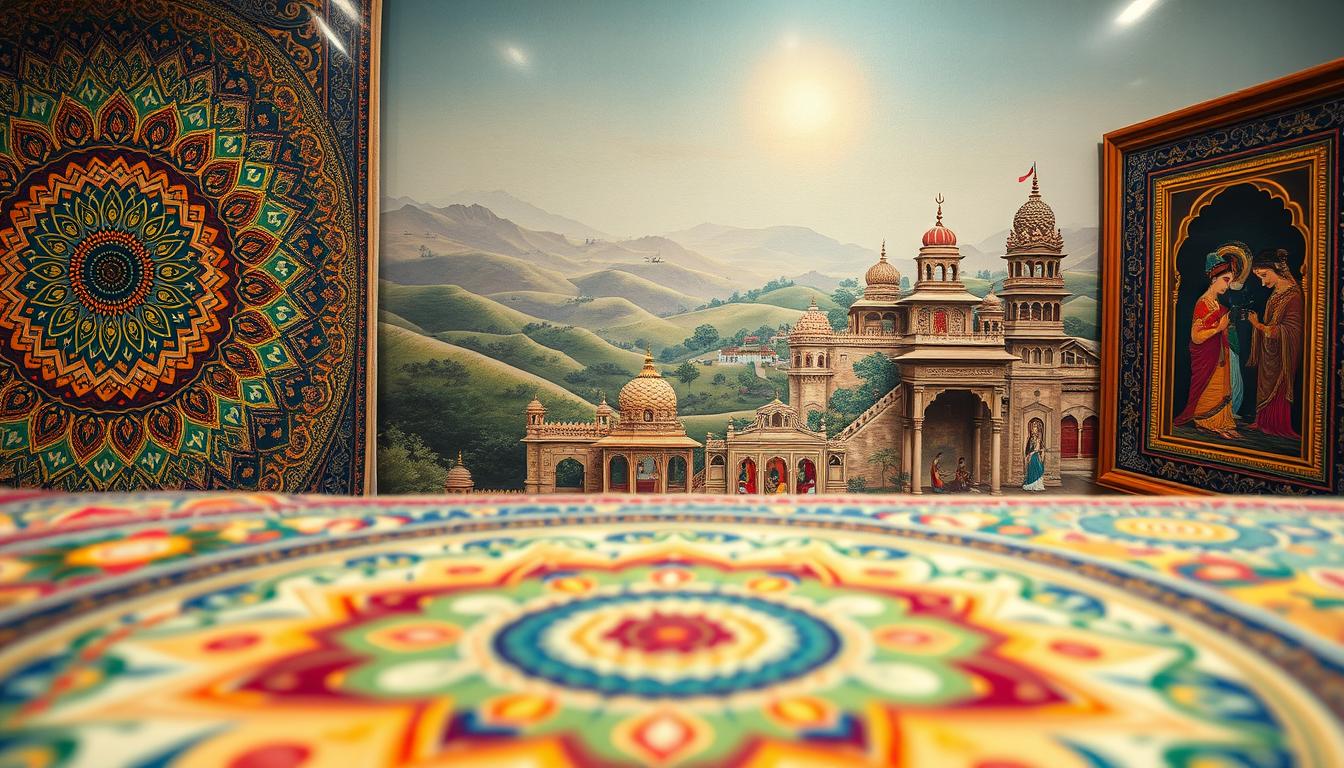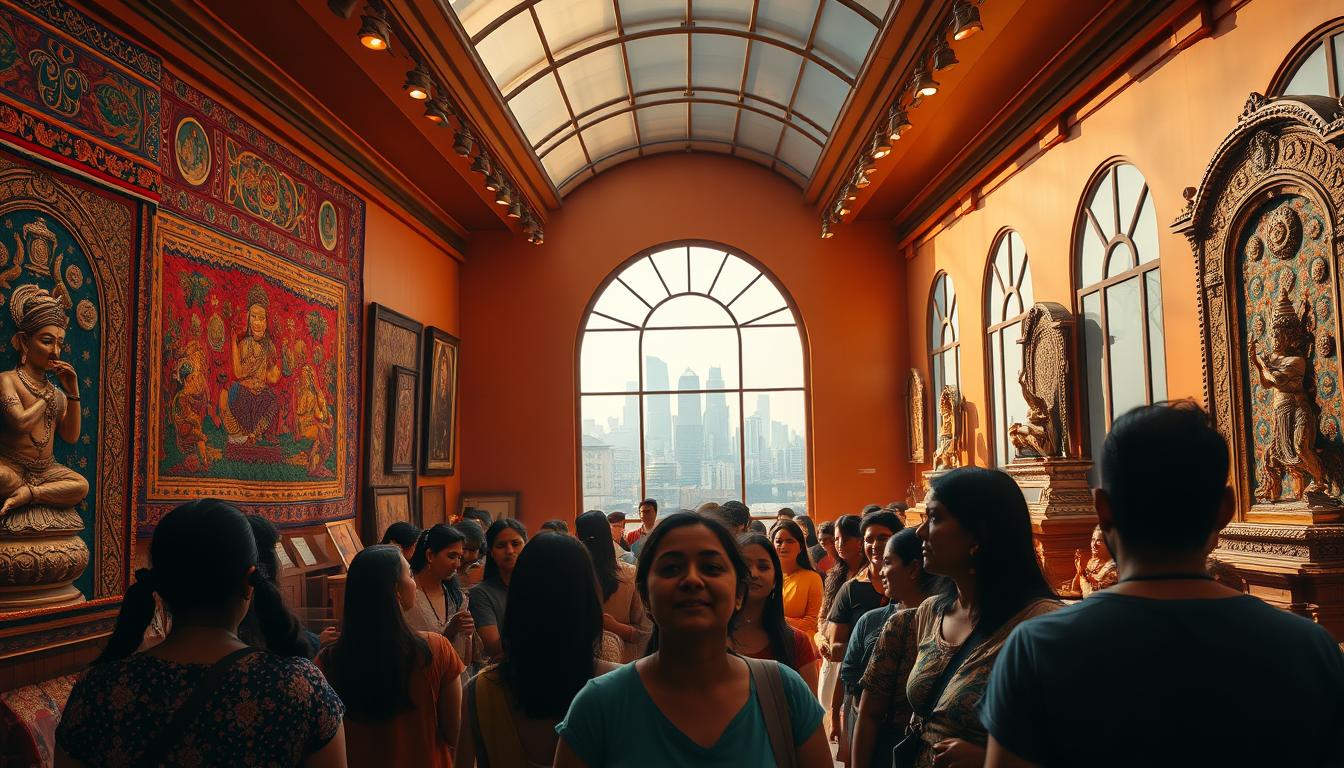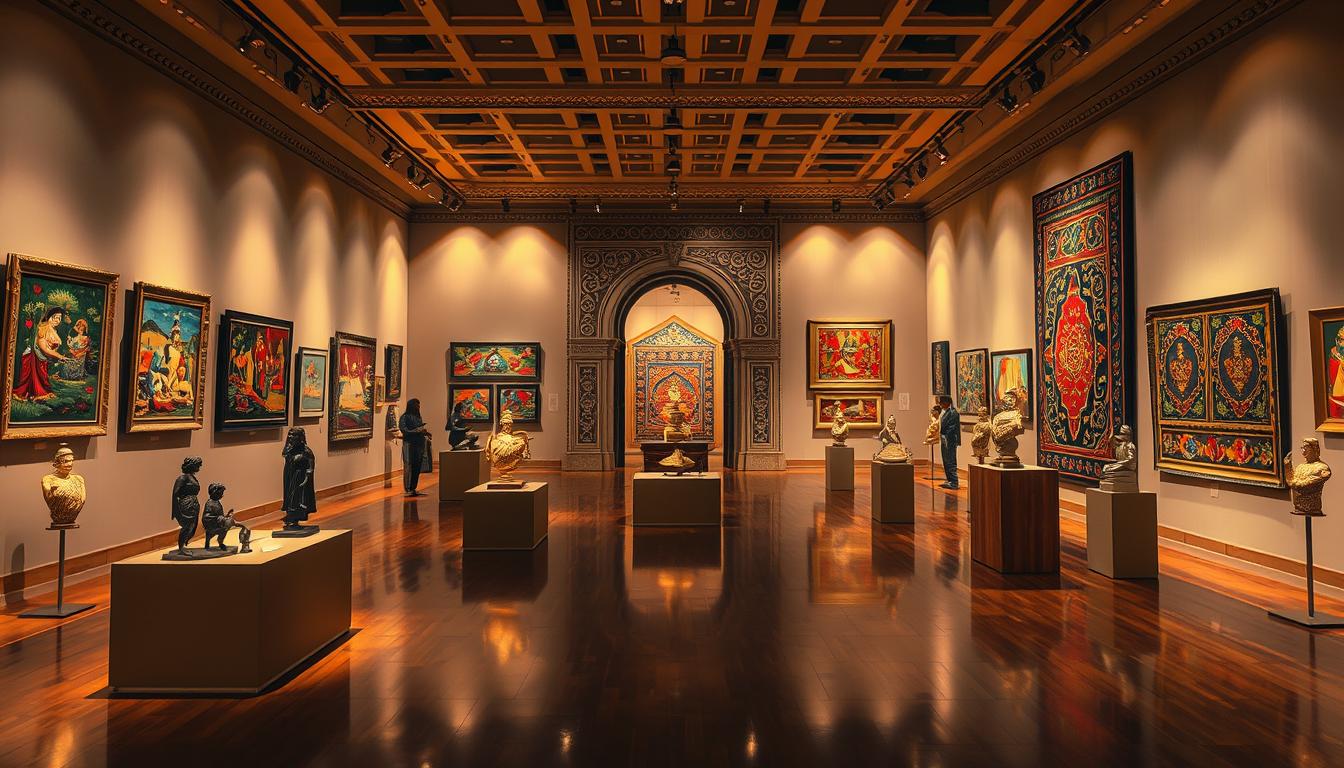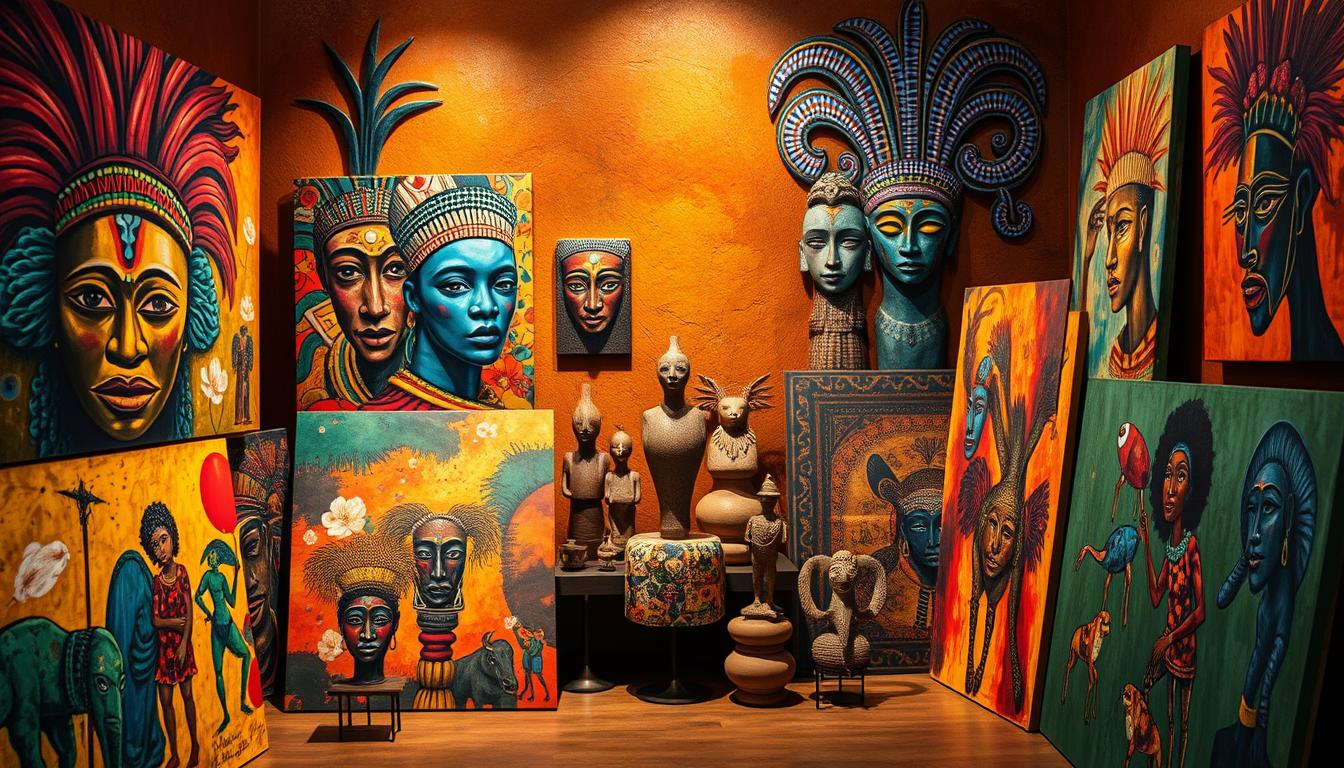I’ll never forget my first time seeing traditional Indian art paintings. The details, colors, and stories took me to a world full of history. These paintings are more than just art—they show the soul of a civilization.
Indian art paintings are more than art. They tell the story of India’s rich culture. From Madhubani’s patterns to Pattachitra’s scrolls, each style has its own tale.
Exploring these paintings, you’ll see how artists turn simple things into amazing works. My journey through these traditions has been magical.
Key Takeaways
- Indian art paintings reflect centuries of cultural heritage
- Each painting style tells a unique cultural story
- Traditional techniques preserve ancient artistic methods
- Colors and patterns carry deep symbolic meanings
- Indian art continues to evolve while respecting tradition
The Rich History of Indian Art Paintings
Indian art paintings take us on a stunning journey through time. They show the growth of culture and art. From ancient cave walls to detailed canvases, these paintings tell stories and keep culture alive.
The history of Indian folk art goes back thousands of years. It tells a story of artistic growth. Let’s explore this amazing journey together.
Origins and Influences
Ancient Indian art was deeply spiritual. Artists used natural materials to create beautiful stories:
- Charcoal for dark tones
- Powdered leaves for green hues
- Turmeric for vibrant yellows
- Rice flour for delicate white spaces
Evolution Through Time
The history of traditional Indian paintings is filled with exciting phases:
- Religious Era: Mostly showed gods and cultural scenes
- Medieval Period: Styles like Rajput and Pahari paintings appeared
- Modern Transformation: Today, we see new themes with old techniques
Major Art Movements
Indian folk art has seen big changes over time. From Mughal miniatures to the Bengal School, each movement added something special. They helped shape India’s rich art heritage.
Art is not just a visual experience, but a cultural dialogue spanning centuries.
Traditional Techniques in Indian Art
Indian art paintings show a deep history of artistic expression. The methods used by Indian artists tell a story of culture passed down through generations.
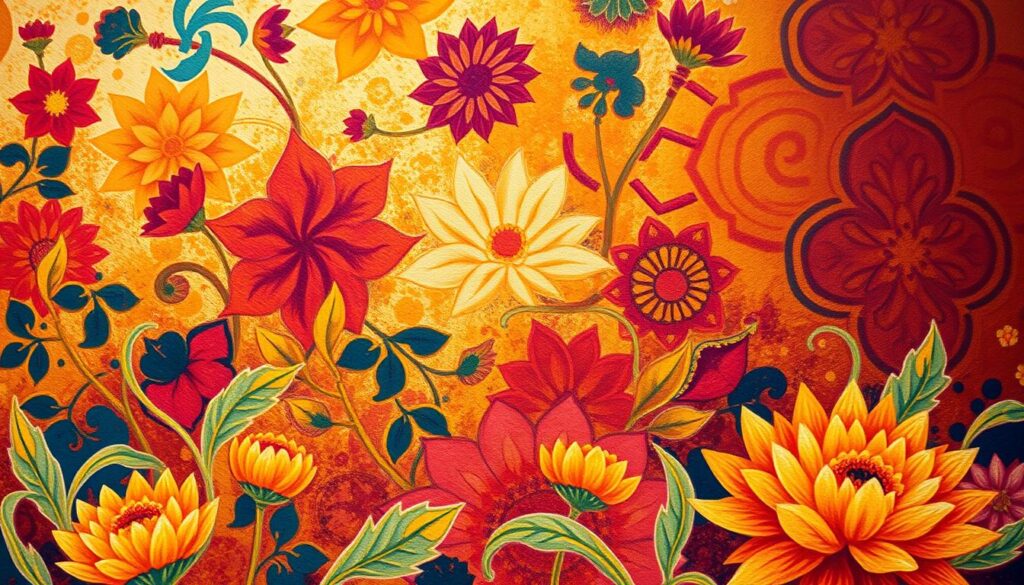
Creating Indian miniature paintings requires great skill and precision. Artists used unique methods to turn simple materials into stunning visual stories.
The Use of Natural Colors
Natural pigments were at the core of traditional Indian art. Artists got colors from amazing sources:
- Iron oxide (hematite) for rich red tones
- Plant saps for vibrant greens
- Charcoal for deep blacks
- Flower petals for delicate pastel shades
Intricate Brushwork
Brushwork in Indian art needs incredible precision. Artists created tiny details with fine brushes, making Indian miniature paintings stand out. The Mughal and Rajput schools were masters at creating fine lines and patterns.
Unique Texturing Methods
Texturing in traditional Indian art is more than just painting. Techniques like gold leaf in Tanjore paintings and geometric patterns in Warli art show the creativity of artists.
Each brushstroke tells a story, each color carries a cultural memory.
These traditional techniques continue to inspire today’s artists. They keep the legacy of Indian art paintings alive and vibrant.
Understanding Different Styles of Indian Art
Indian folk art is a colorful mix of cultural stories. Each painting style tells a unique tale of its region. These traditions show the heart of community, spirituality, and everyday life through special visual languages.
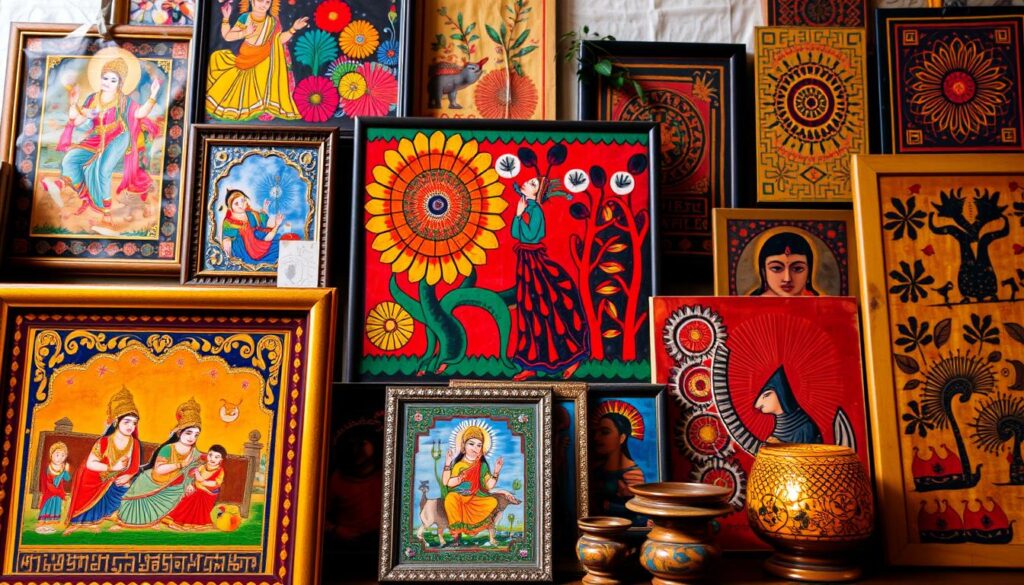
Let’s dive into three amazing styles that show the richness and variety of Indian art:
Madhubani Painting: A Colorful Narrative
Madhubani paintings come from Bihar and are known for their bright colors and detailed patterns. These paintings feature:
- Mythological scenes with gods and goddesses
- Intricate geometric designs
- Natural pigments and handmade brushes
- Cultural stories passed down through generations
Warli Art: Simplicity in Expression
Warli art from Maharashtra is different with its simple style. This folk art is known for:
- Stick-figure drawings
- White geometric shapes on earthy backgrounds
- Scenes of community life and farming
- Use of natural materials like rice paste
Pattachitra: Storytelling Through Art
The Pattachitra tradition from Odisha brings ancient stories to life on scrolls. These paintings show:
- Detailed narrative compositions
- Mythological and religious themes
- Vibrant color palettes
- Meticulous brushwork and storytelling techniques
Each art style offers a special glimpse into India’s rich cultural heritage. They keep stories and traditions alive through visual storytelling.
Iconic Themes and Subjects in Indian Art
Indian art paintings show the vibrant culture of the subcontinent. They tell stories and use symbols in a deep way. This art captures the essence of India.
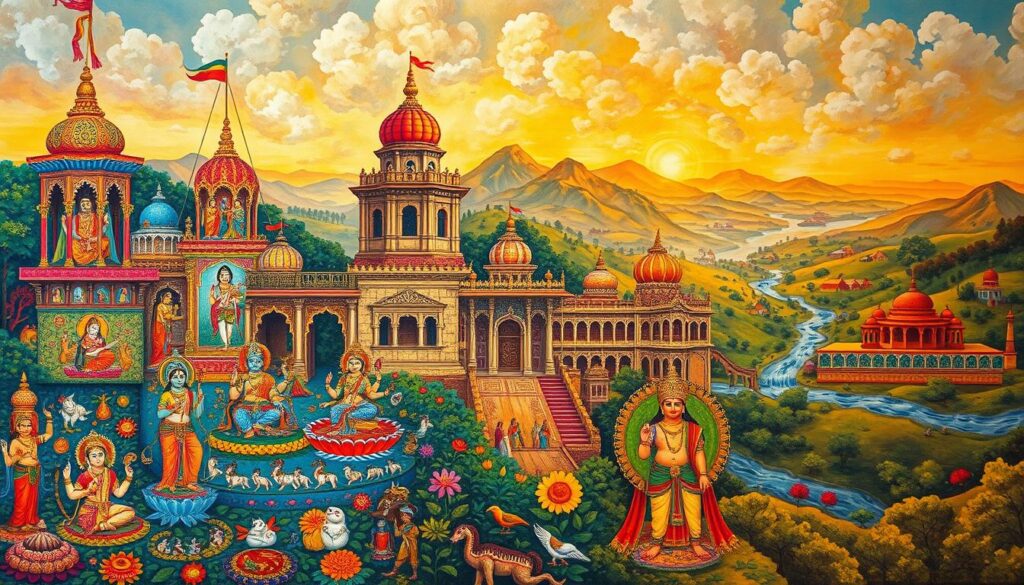
Looking into contemporary Indian art, we find many themes that artists have loved for years:
Mythology and Spirituality
Art often draws from spiritual stories. Artists turn old tales into beautiful pictures. They bring gods like Krishna and Shiva to life with their art.
Nature and Animals
The natural world is key in Indian art today. Artists show:
- Beautiful landscapes with bright colors
- Stylized animals
- Details of plants and animals
Daily Life and Culture
Art captures everyday life and traditions. It shows both rural and city scenes. These works give us a deep look into society and people.
Art is not just about creating beauty, but about telling stories that resonate across generations.
The high prices of Indian art show its value. For example, Raja Ravi Varma’s Radha in the Moonlight sold for Rs. 20 crores. This shows how much people value these cultural treasures.
The Role of Indian Art in Festivals
Indian art brings life to cultural celebrations, making festivals colorful and full of creativity. It ranges from detailed rangoli designs to big paintings. Art connects communities and keeps cultural heritage alive.
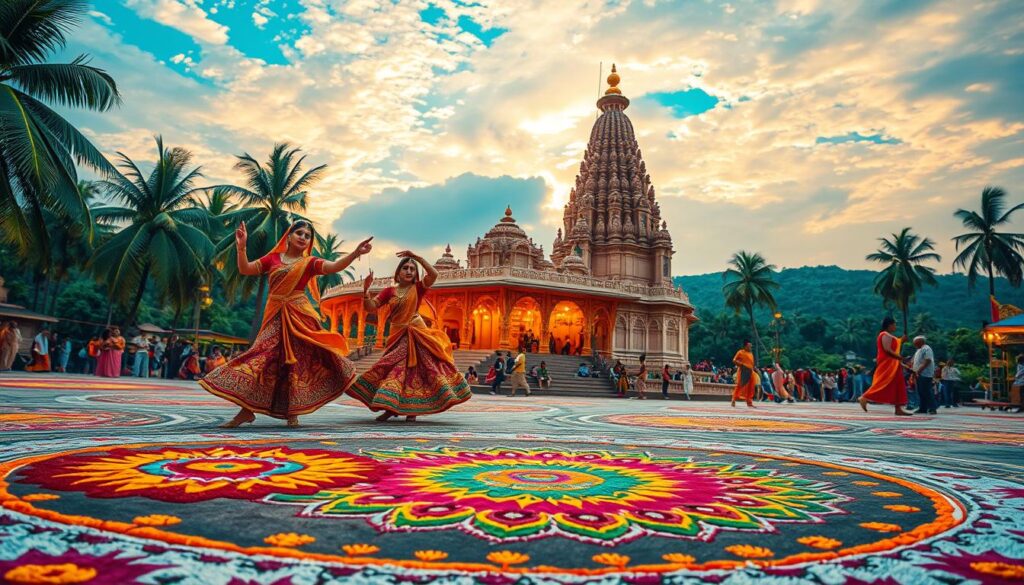
Festivals are a great chance to show off India’s rich artistic traditions. Artists and craftspeople use these times to show off their skills. They share stories through different art forms.
Religious Celebrations
Art becomes a spiritual language in religious festivals. Traditional art forms tell divine stories and capture sacred moments. Rooftop workshops help keep these traditions alive.
- Madhubani paintings during Diwali
- Warli art in Maharashtra’s religious events
- Pattachitra scrolls in Odisha’s temple festivals
Cultural Exhibitions
Modern Indian art galleries are making traditional art more accessible. Online platforms now show these amazing art forms. They let people worldwide see India’s rich cultural heritage.
- Urban festivals bridging traditional and contemporary art
- Exhibitions promoting local artisan crafts
- Digital platforms expanding Indian art online
Artistic Showcases
Festivals are dynamic stages for artists to celebrate creativity. They support local craftspeople and keep cultural traditions alive. Through detailed designs and powerful stories, these showcases keep India’s art traditions vibrant.
Prominent Indian Artists to Know
Indian modern art is filled with talented creators. They have changed the art world. Let me introduce you to some famous Indian artists who have made a big impact.
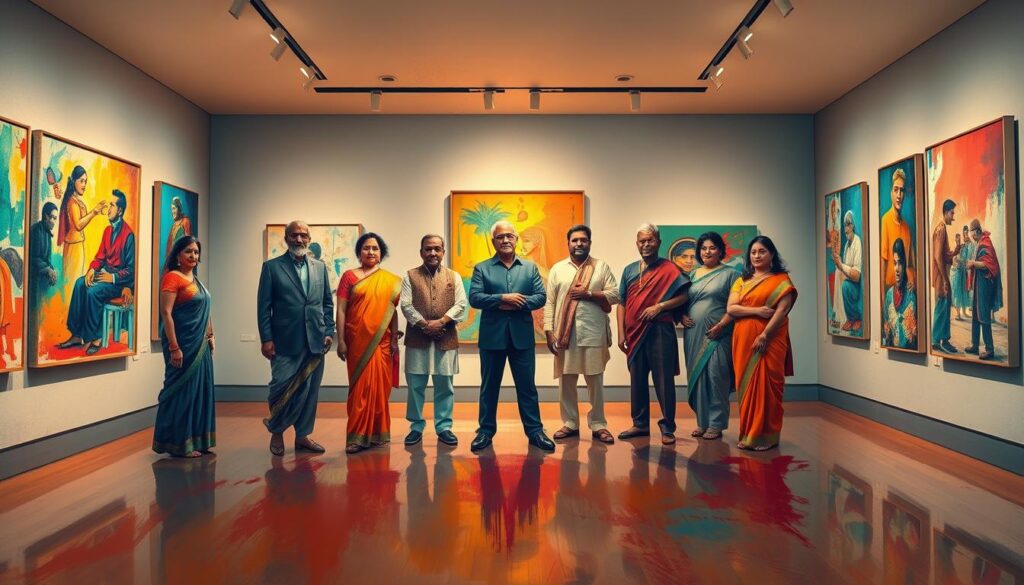
Join me on a journey through the work of groundbreaking artists. They have shaped contemporary Indian art movements.
Raja Ravi Varma: The Pioneer of Modern Indian Art
Raja Ravi Varma was a key figure in Indian modern art. He brought mythological stories to life with realistic oil paintings. His work mixed traditional Indian tales with European painting styles, making art more popular.
Jamini Roy: Celebrating Folk Traditions
Jamini Roy changed Indian art by using traditional Bengali folk art. His style was simple, with bold colors. This created a vibrant way to celebrate India’s culture.
- Simplified geometric figures
- Bright, flat color palettes
- Strong connection to rural artistic traditions
Tyeb Mehta: Breaking Artistic Boundaries
Tyeb Mehta was a major figure in Indian modern art. His paintings tackled tough themes like human suffering and social change. Mehta’s use of figural abstraction pushed the limits of traditional art.
“Art is not about perfect reproduction, but emotional translation” – Tyeb Mehta
These artists are just a few examples of India’s rich artistic history. Each one has added something special to the world of Indian modern art.
How to Incorporate Indian Art in Home Decor
Adding Indian art to your home can make it stunning. It brings in vibrant colors and deep stories. These elements can make any room special.
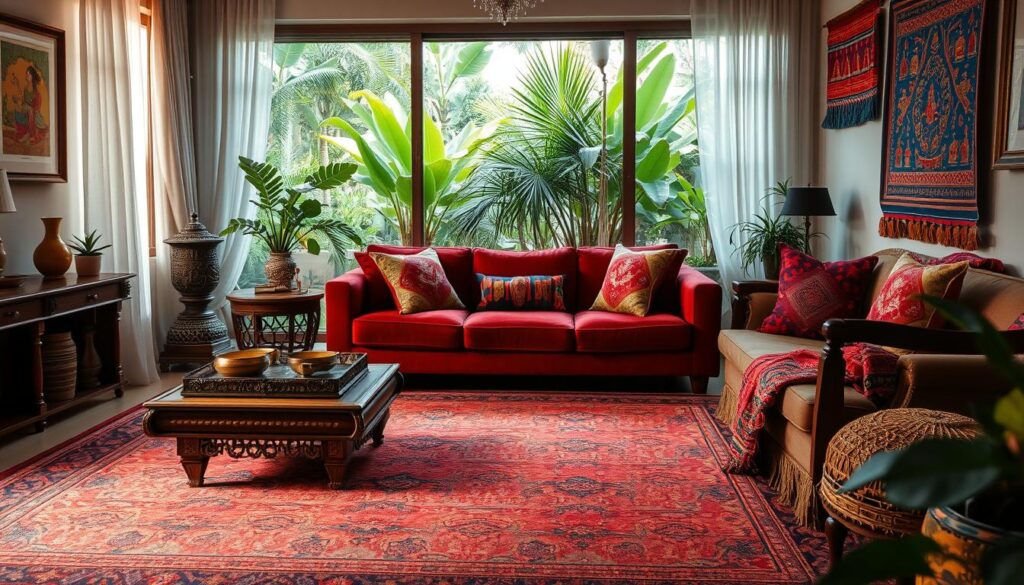
Let’s explore how to add Indian art to your decor. It’s about finding pieces that match your style and honor their cultural roots.
Choosing the Right Style
When picking Indian art online, look at these styles:
- Madhubani: Bright paintings with geometric patterns and stories from mythology
- Warli: Tribal art with simple shapes showing everyday life and nature
- Tanjore: Rich paintings with gold foil and religious scenes
- Pichwai: Detailed Krishna-inspired art great for making a statement
Display Techniques
How you display your art can make it stand out. Here are some tips:
- Make a gallery wall with many small pieces
- Highlight details with dramatic lighting
- Use different sizes and frames for interest
- Choose frames that match the artwork’s style
Combining with Modern Design
Mixing Indian art with modern decor needs care. Balance is key. Pick pieces that fit your colors and furniture.
Brass statues, embroidered fabrics, and chosen paintings can fit many styles. They add beauty and tell a cultural story.
The Growing Popularity of Indian Art in the U.S.
The contemporary Indian art scene is booming in the United States. More and more people are interested in the vibrant and new works coming from India.

Recent auction records show how fast contemporary Indian art is growing worldwide. Some highlights include:
- Sayed Haider Raza’s painting “The Rugged Landscape” selling for EUR 4.7 million
- F.N. Souza’s “The Lovers” reaching $4.89 million at Sotheby’s
- Christie’s South Asian art sales achieving a 100% sell rate of $19.7 million
Contemporary Art Scene
Indian art galleries in the U.S. are showing off more diverse and bold works. The India Art Fair 2024 is a great example, with over 100 exhibitors from around the world. Young collectors are also helping this market grow, bringing new ideas to Indian art.
Art Exhibitions and Shows
Big U.S. cities are hosting exciting exhibitions that show off Indian artists’ talent. The opening of places like the Nita Mukesh Ambani Cultural Centre has made people worldwide more interested in Indian art.
Emerging Indian Artists
A new group of artists is mixing old techniques with new ideas. Online platforms and galleries are giving these artists a big stage. This makes Indian art more available than ever before.
The Indian art market has achieved a remarkable 76% growth in 2023, ranking 7th globally in the secondary art market.
Collecting Indian Art Paintings
Exploring Indian art for sale is thrilling for art lovers and collectors. It’s key to know how to buy authentic Indian art, whether you’re new or experienced.
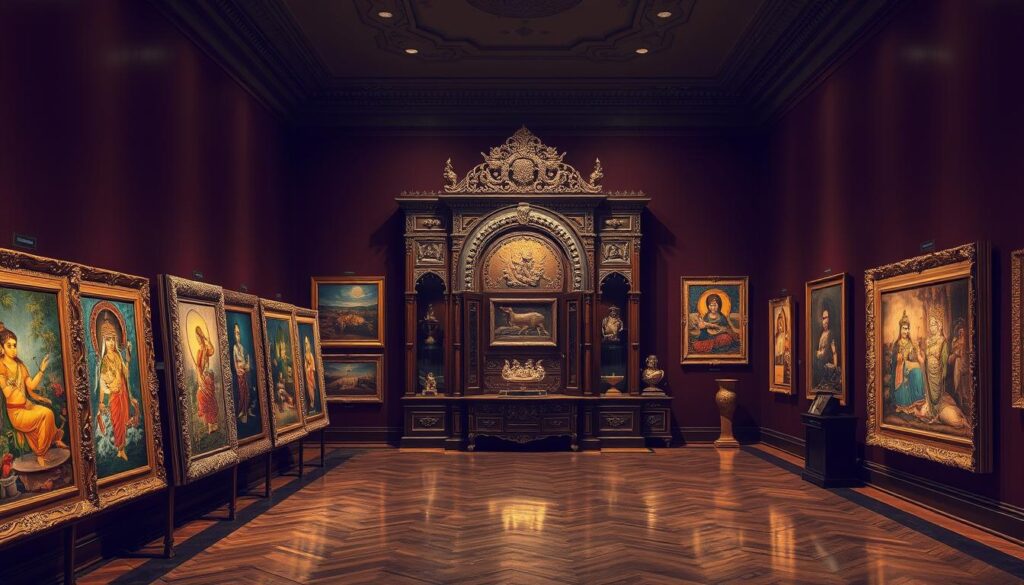
Finding Indian art online needs thought and knowledge. I’ll give you tips to start or grow your collection of traditional and modern Indian paintings.
Where to Buy Authentic Pieces
- Reputable online platforms specializing in Indian art
- Established art galleries with curated collections
- Auction houses featuring verified Indian artworks
- Direct partnerships with recognized artists
Auction Houses and Galleries
Choosing the right place to buy Indian art is important. Renowned auction houses like Sotheby’s and Christie’s showcase top Indian art. Local galleries let you see art up close and talk to experts.
Evaluating Art Value
- Artist’s reputation and historical significance
- Artwork’s condition and preservation
- Provenance and authentication certificates
- Unique artistic techniques
- Cultural and historical context
When looking at Indian art for sale, notice the style, regional touches, and the story it tells. Prices range from affordable prints to rare collector’s items.
Pro tip: Always request a certificate of authenticity when purchasing Indian art online to ensure you’re investing in a genuine piece.
With thorough research and a keen eye, you can create a stunning collection that honors India’s rich art history.
Resources for Learning About Indian Art
My love for Indian art paintings has uncovered amazing resources. These help art lovers dive into this rich culture. Whether you’re new or have a lot of experience, there are many ways to learn more about Indian art.
Online learning platforms have changed art education. I suggest checking out courses from places like the MAP Academy. They offer special programs in Indian art history. Sites like Coursera and edX have virtual workshops on traditional and modern Indian art.
For those who like to read, there are great books to explore. “The Secret Kingdom” by Barb Rosenstock is a deep dive into Indian creativity. Britannica and museums like the Metropolitan Museum of Art have books and articles on Indian art history.
If you want to see Indian art in person, visit museums with Asian art sections. The Smithsonian’s Asian Art collection and local museums have Indian art exhibits. You can also enjoy virtual tours and online galleries to see Indian art from anywhere.
Source Links
- https://blog.mojarto.com/indian-artistry-10-distinct-types-of-paintings-in-india/ – Indian Artistry: 10 Distinct Types of Paintings In India – Art Blogs & Videos | Learn Art Investment | Explore, Experience Art
- https://www.exoticindiaart.com/paintings/ – Indian Artwork : Miniature Paintings, Thangka, Madhubani & Oil Paintings
- https://theasifkamal.com/blog/2018/01/28/indian-art-extraordinarily-beautiful-integral-part-indian-culture/ – Indian Art- extraordinarily beautiful and integral part of Indian Culture – Asif Kamal Blog
- https://satgurus.com/blogs/news/exploring-the-history-of-indian-painting-from-ancient-to-contemporary?srsltid=AfmBOopsW1s08Ek4eiGwVwDxQHyeissNakWjX3iQpa38DJgyWJikvbKO – Exploring The History Of Indian Painting: From Ancient To Contemporary
- https://www.cottage9.com/blog/tracing-the-origins-of-ancient-indian-art-paintings/ – Tracing The Origins Of Ancient Indian Art Paintings
- https://www.christies.com/en/stories/collecting-guide-classical-indian-painting-376d072a484a41ef8d4a227834d46fa3 – Classical Indian Painting: Collecting guide
- https://en.wikipedia.org/wiki/Indian_art – Indian art
- https://fiveable.me/lists/traditional-indian-art-forms – Traditional Indian Art Forms to Know for Indian Art – 1350 to Present
- https://laasyaart.com/types-indian-paintings-with-different-styles-themes/ – Types of Indian Paintings: Different Styles, Themes That Describe Indian Art – Laasya Art
- https://art.rtistiq.com/en-us/blog/traditional-indian-art-styles-in-modern-age?srsltid=AfmBOoqIN_o7l-suIZ-rwAYbJYb5-5F_HVnPgxqqelhx_NSSBxtIwDEG – Traditional Indian Art Styles in Modern Age
- https://www.artisera.com/blogs/expressions/nine-gems-of-indian-art?srsltid=AfmBOoqXx2JEvBy4lygtaCJ_3nqQ8RYAJpyKyUZmIjnOxw2kSQ8o-FsI – The Nine Gems of Indian Art
- https://www.trocals.com/famous-art-forms-of-india/ – 15 Famous Art Forms Of India That Shows You The Indian Heritage
- https://alokya.com/blogs/news/the-cultural-importance-of-indian-festivals-in-art-and-craft?srsltid=AfmBOopVQgDMiuJ0xtzdFd4H0RXIWiaHySSsddCTg25iym1cE42fzMN6 – The Cultural Importance of Indian Festivals in Art and Craft
- https://blog.artlounge.in/blog/2021/8/30/indian-art-forms – Indian Art Forms — Art Lounge
- https://www.artflute.com/artists?srsltid=AfmBOorNVFmF2jWGNpNu5PbGN4lvrUYyoIysKjYmpNLGOEioVsxFUhId – Famous Indian Artists & Contemporary Painters Online
- https://fiveable.me/lists/famous-contemporary-indian-artists – Famous Contemporary Indian Artists to Know for Indian Art – 1350 to Present
- https://www.memeraki.com/blogs/posts/how-to-incorporate-indian-art-in-contemporary-living-room?srsltid=AfmBOopPM4S7Brx5UmsGrH-hN9rUNtz19jikUxAOoz1D6qlR50so0kBZ – How to Incorporate Indian art in contemporary living room
- https://blog.indiacircus.com/home-decor-ideas-to-reflect-traditional-indian-art/ – IndiaCircus
- https://www.marble-lotus.com/blogs/indian-inspired-home-decor-blog/how-to-infuse-your-home-with-indian-decor-a-beginners-guide?srsltid=AfmBOooApOWsBDE-5c0UFuwAa7KhV620sx2x75CE72FDKRDwha4p83rW – 10 Must-Have Indian Decor Pieces for Your Home
- https://www.artprice.com/artmarketinsight/rise-of-indian-artists-the-case-of-sayed-haider-raza-and-the-latest-new-york-results – Rise of Indian artists: the case of Sayed Haider Raza and the latest New York results – Artmarketinsight
- https://www.artsy.net/article/artsy-editorial-india-s-art-market-thriving-here-s – India’s Art Market Is Thriving—Here’s Why
- https://www.memeraki.com/collections/paintings?srsltid=AfmBOooHUiYPZ-eusgTIt8ReAgAAB1Vcwzn-xGRSRtBW3DEKAz9Ib5FU – Handpainted Paintings by Masters: A Timeless Collection of Indian Artworks
- https://www.artflute.com/?srsltid=AfmBOoobIuLjJpDD7-BV_20jdMh_V4S1EnEafS9Q13qROvoav9Kc6YX7 – Buy Authentic Indian Art Paintings Online | Beautiful Indian Art
- https://thebimba.com/collections/classical-indian-art?srsltid=AfmBOopwALiu4F1vxzDxtCRZPwAleLWtBi_5K42C1kVBoXHPwqBYT0Gq – Genuine Classical Indian Art Paintings & Classical Indian Art Artworks
- https://new.artsmia.org/learning-resources/teaching-the-arts/tta/five-facts/indian-art/ – No title found
- https://ccplonline.org/blogs/childrens/art-exploration-art-of-india/ – Art Exploration: Art of India
- https://mapacademy.io/ – Resource on the History of Art in South Asia | MAP Academy
